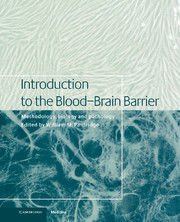Book contents
- Frontmatter
- Contents
- List of contributors
- 1 Blood–brain barrier methodology and biology
- Part I Methodology
- Part II Transport biology
- Part III General aspects of CNS transport
- 27 The blood-CSF barrier and the choroid plexus
- 28 Arachnoid membrane, subarachnoid CSF and pia–glia
- 29 Circumventricular organs of the brain
- 30 Transport in the developing brain
- Part IV Signal transduction/biochemical aspects
- Part V Pathophysiology in disease states
- Index
30 - Transport in the developing brain
from Part III - General aspects of CNS transport
Published online by Cambridge University Press: 10 December 2009
- Frontmatter
- Contents
- List of contributors
- 1 Blood–brain barrier methodology and biology
- Part I Methodology
- Part II Transport biology
- Part III General aspects of CNS transport
- 27 The blood-CSF barrier and the choroid plexus
- 28 Arachnoid membrane, subarachnoid CSF and pia–glia
- 29 Circumventricular organs of the brain
- 30 Transport in the developing brain
- Part IV Signal transduction/biochemical aspects
- Part V Pathophysiology in disease states
- Index
Summary
Introduction
General textbooks of physiology still tend to refer to ‘the’ blood–brain barrier as though it were a single entity (e.g. Ganong, 1995). However, it is quite clear, at least to those in the field, that the term is now used to describe a wide range of physiological mechanisms that control the composition of the internal environment of the brain to an even greater extent than the mechanisms that control the ‘milieu interieur’ of the organism as a whole. Nevertheless, there is a sense in which there is a single underlying barrier, namely the presence of a diffusion barrier at the blood–brain and blood–CSF (cerebrospinal fluid) interfaces. This takes the form of tight junctions between adjacent endothelial cells in the cerebral vessels (blood–brain barrier) and between the epithelial cells of the choroid plexus (blood–CSF barrier). The barrier at the blood–brain interface prevents almost absolutely the penetration of macromolecules such as proteins and of ligands that bind to proteins (e.g. some dyes and drugs). For small molecules there is a degree of permeability that is directly proportional to molecular weight. For the blood-CSF interface, the range of molecular size that can penetrate into CSF by diffusion is much greater.
- Type
- Chapter
- Information
- Introduction to the Blood-Brain BarrierMethodology, Biology and Pathology, pp. 277 - 290Publisher: Cambridge University PressPrint publication year: 1998
- 5
- Cited by



